Introduction
Situated on the River Tiber in the Lazio region, Rome or the ‘Eternal City’, is the seat of Italy’s government. The sheer amount of history envelops you the minute you arrive in Rome, making the city and particularity the centro storico appear much like an open-air museum. With over four hundred churches, several stunning basilicas, countless ruins as well as some of the world’s most beautiful piazzas and fountains Rome has much to offer. The legendary beginnings of Rome are well documented, with such illustrious past rulers as Julius Caesar and Nero; Rome is very much the heart of European civilization.Across the River Tiber to the west lies the Vatican State, which is home to the Pope and the heart of the Roman Catholic Church. Clearly tourism is a major source of income for this city and until recently the city had been criticized for its poor infrastructure. However in anticipation of the estimated thirty million visitors for the millennium, much was restored and improved.
Rome is blessed with a warm Mediterranean climate, the best times to visit are in spring and autumn, the summer months however do get very hot. Only two hours from both Naples and Florence, Rome is located very centrally. Similarly, the seaside isn’t too far away providing a pleasant getaway for Romans during the hot summer months.







